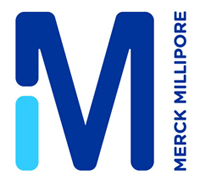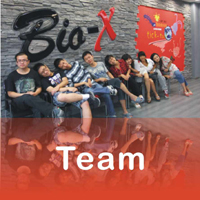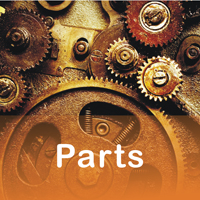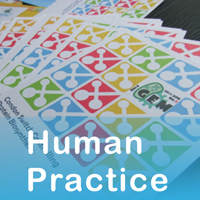Team:SJTU-BioX-Shanghai
From 2011.igem.org
| Line 25: | Line 25: | ||
top:690px; left:2px; | top:690px; left:2px; | ||
width:200px; | width:200px; | ||
| - | } | + | height:1000px;} |
.s{ | .s{ | ||
Revision as of 18:19, 28 October 2011
Countdown
SJTU-BioX-Shanghai iGEM team is designing a set of Codon-Switches that regulate target protein biosynthesis (translation).
In our Rare-Codon Switch, the translation of the protein can be finely turned up/down with the control of rare tRNA amount, aaRS that charges the rare tRNA and rare codons.
Besides, our device can be made into switches that can be turned on/off without background noise in two ways. One is to use stop codon as the controlling element, the Stop-Codon Switch. The other is to use any codon but the original start codon to initiate translation, the Initial-Codon Switch.
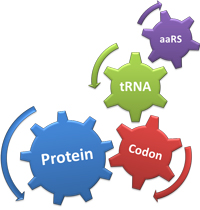
Our design has expanded the regulating tools for synthetic biology and introduced brand-new methods for protein function analysis. See more about project applications, click here.
 Developed tRNA and aminoacyl tRNA synthetase (aaRS) from the natural biological system into the Modulator, a controlling device for protein biosynthesis. The function of this device has been fully characterized. Brand-new features of the device are also discovered.
Developed tRNA and aminoacyl tRNA synthetase (aaRS) from the natural biological system into the Modulator, a controlling device for protein biosynthesis. The function of this device has been fully characterized. Brand-new features of the device are also discovered.
 Constructed 4 Modulators (including 8 biobricks) and 13 Reporter biobricks in our 3 subprojedts to test our controlling system. Create parts, including our favorite parts have been sent to Registry.
Constructed 4 Modulators (including 8 biobricks) and 13 Reporter biobricks in our 3 subprojedts to test our controlling system. Create parts, including our favorite parts have been sent to Registry.
 Modified pre-existing reporter genes luciferase and RFP and created a series of new reporter genes. These reporters have been excellent devices in characterizing our system.
Modified pre-existing reporter genes luciferase and RFP and created a series of new reporter genes. These reporters have been excellent devices in characterizing our system.
 Built our Rare-Codon Switch in silic and demonstrated the reliability of the modelthrough our experiment results. The data in silic and data experimental matches well.
Built our Rare-Codon Switch in silic and demonstrated the reliability of the modelthrough our experiment results. The data in silic and data experimental matches well.
 Analyzed the structure of 18 aaRS with structural biological methods. Designed structures of 14 modified aaRS deprived of their anticodon recognition ability. This work can be used to expand our device aaRS Modulator.
Analyzed the structure of 18 aaRS with structural biological methods. Designed structures of 14 modified aaRS deprived of their anticodon recognition ability. This work can be used to expand our device aaRS Modulator.
 Designed two different models for how our device can be applied to controlling metabolic networks, which expands the regulating tools for synthetic biology.
Designed two different models for how our device can be applied to controlling metabolic networks, which expands the regulating tools for synthetic biology.
 Developed two brand-new ways that facilitate the study of protein structure. One for incorporating point mutation into protein. The other for producing truncated proteins to help study the important protein domains.
Developed two brand-new ways that facilitate the study of protein structure. One for incorporating point mutation into protein. The other for producing truncated proteins to help study the important protein domains.
 Design our Human Practice Project: T-PostCards to promote our views on synthetic biology through communications and connections.
Design our Human Practice Project: T-PostCards to promote our views on synthetic biology through communications and connections.
 Attended the 2011 China Meet Up and presented our project idea to other iGEMer and advisors.
Attended the 2011 China Meet Up and presented our project idea to other iGEMer and advisors.
 "
"

